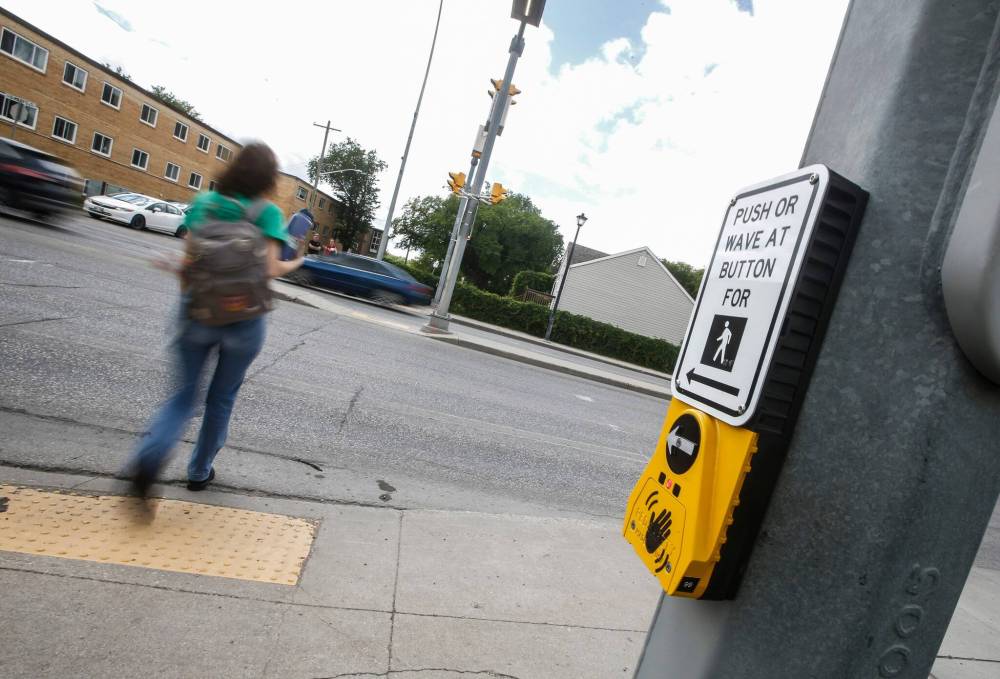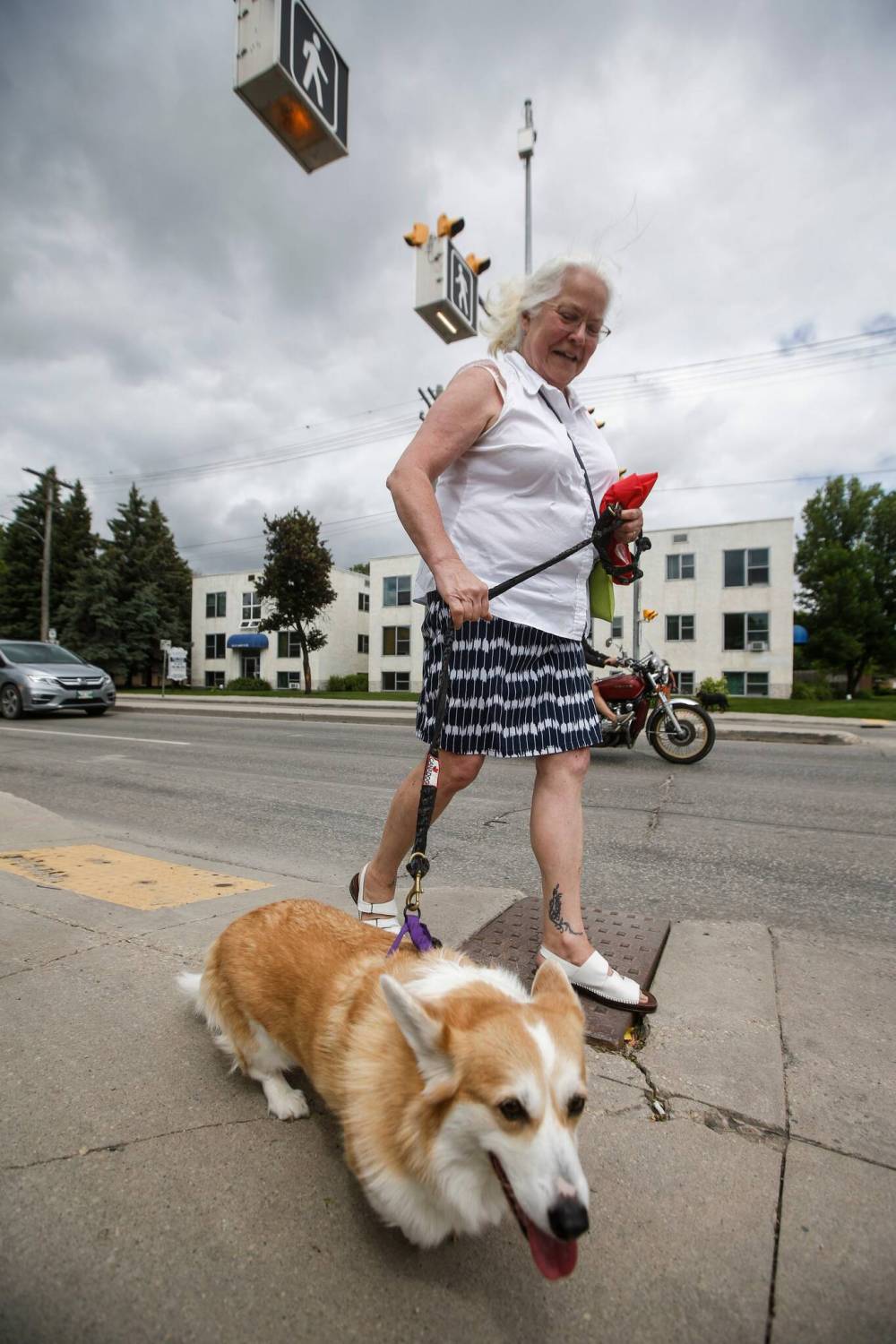Pedestrians now have more time to safely cross the entire street at a few signalled crosswalks, while more crossing time limits could be lengthened in future.
The City of Winnipeg has upgraded three signalled pedestrian crossings to make them safer and will assess whether additional upgrades are needed during routine maintenance checks at other sites.
So far, improvements have been made to the crosswalks at: Jarvis Avenue and Main Street; Dearborn Avenue and Henderson Highway; and Carriere Avenue and St. Mary’s Road.

JOHN WOODS / FREE PRESS
The city has added lights and extra time to cross at several crosswalks.
“I really think anything we can do to improve safety for the vulnerable road user, being a pedestrian or cyclist, is really important… We can always do more,” said Coun. Janice Lukes, chairwoman of public works.
The changes include extending the crossing time by one second to 29 seconds, adding lower flashing amber lights and removing buttons on the median at Dearborn and Henderson. Lower lights were also added, with median buttons also removed at Jarvis and Main.
At Carriere and St. Mary’s, the changes included adding lower flashing amber lights, removing median buttons and increasing the crossing time from 22 to 26 seconds.
Lukes (Waverley West) said she’d like to see broader work on the issue but that effort is limited by budget constraints.

JOHN WOODS / FREE PRESS
Vicki Harris-Clarkson and Kira use a new crosswalk at St. Mary’s Road and Carriere Avenue.
“We should (continue to do) this where we can and where the budget allows. So, they’ve picked priority crosswalks and that’s a good thing,” she said.
City traffic specialists say removing crossing buttons at crosswalks with narrow medians is meant to deter people from stopping in the middle of a crossing, while added crossing time helps them cross the whole road.
Pedestrians using the Carriere and St. Mary’s crossing generally welcomed the added time given to pedestrians to cross on foot, as well as the lower lights.
“We need more of them. I like that the lights are more in your line of vision, so you’re not looking up (for drivers.) That’s a real plus,” said Vicki Harris-Clarkson.
Jay Nault said he also found the improved lighting easier to spot but didn’t like the removal of the median light activation buttons.
“It doesn’t seem safer at all to me. …My grandma (who is 77), there’s no way she’d make it fully across in 26 seconds, it would never happen… You’ve now lost the control of hitting that light (in the middle),” said Nault.
Requests to speak with city traffic experts were not granted.
“I like that the lights are more in your line of vision, so you’re not looking up (for drivers.) That’s a real plus.”–Vicki Harris-Clarkson
In an email, a city spokeswoman said making pedestrians less likely to stop at narrow medians would address multiple safety issues.
“Some medians are quite narrow, so the risk of a vehicle-pedestrian collision increases. Others are wide enough for a single pedestrian to stop, but simply are not large enough for groups of people, wheelchair users, people with strollers, etc. Additionally, someone stopping on a median in winter has a greater risk of slipping into traffic. To keep everyone safe, we want people to change their habits and avoid stopping on the median,” wrote Julie Horbal Dooley.
At locations with wider medians, the city could replace some dual-button poles (one pole with a button for each direction of travel) with two poles that clearly show the direction each controls.
It’s not clear how many crosswalks will be updated or when that will take place.
“At this time, there is no timeline or budget for the change to be implemented as we are still determining where these changes are appropriate as we examine each intersection as part of our routine reviews,” wrote Horbal Dooley.
She said the changes aren’t a response to crashes or road safety incidents but are based on “an observation of human behaviour and evolving knowledge of how we can make things easier, safer, and more efficient.”
An advocate, who is lobbying the city to reduce speed limits on all residential streets to 30 km/h and add pedestrian safety measures, welcomed the changes, though he’d prefer a commitment for all crosswalks to be assessed and improved.
“Some people are slower than other people, especially with an aging population… They’ll need a little bit more time to cross the street,” so I think (that change is) great,” said Ian Walker, chairman of Safe Speeds Winnipeg.
Walker said he expects motorist safety to improve as well, since pedestrians who are less rushed would be more likely to double-check if vehicles have come to a stop before proceeding into an intersection.
“Just allowing time for traffic to stop (helps),” he said.
joyanne.pursaga@freepress.mb.ca
X: @joyanne_pursaga

Joyanne Pursaga
Reporter
Joyanne is city hall reporter for the Winnipeg Free Press. A reporter since 2004, she began covering politics exclusively in 2012, writing on city hall and the Manitoba Legislature for the Winnipeg Sun before joining the Free Press in early 2020. Read more about Joyanne.
Every piece of reporting Joyanne produces is reviewed by an editing team before it is posted online or published in print — part of the Free Press‘s tradition, since 1872, of producing reliable independent journalism. Read more about Free Press’s history and mandate, and learn how our newsroom operates.
Our newsroom depends on a growing audience of readers to power our journalism. If you are not a paid reader, please consider becoming a subscriber.
Our newsroom depends on its audience of readers to power our journalism. Thank you for your support.